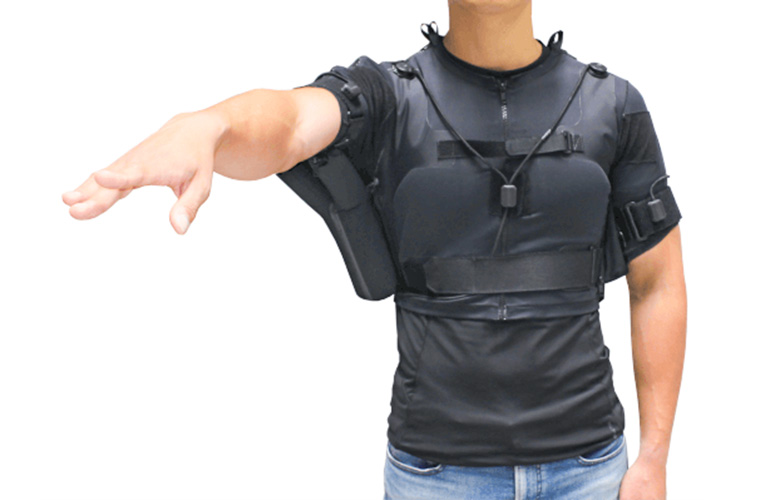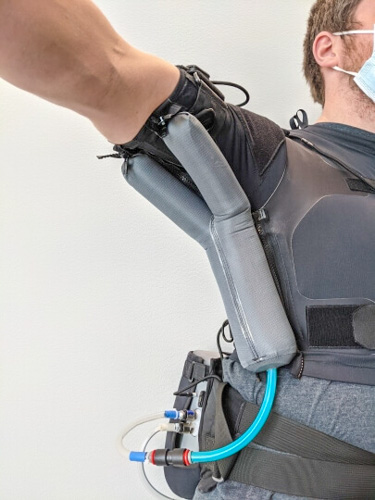Soft robotic wearable restores arm function for people with ALS

This soft robotic wearable is capable of significantly assisting upper arm and shoulder movement in people with ALS. | Credit: Walsh Lab, Harvard SEAS
Some 30,000 people in the U.S. are affected by amyotrophic lateral sclerosis (ALS), also known as Lou Gehrig’s disease, a neurodegenerative condition that damages cells in the brain and spinal cord necessary for movement.
Now, a team of researchers from the Harvard John A. Paulson School of Engineering and Applied Sciences (SEAS) and Massachusetts General Hospital (MGH) has developed a soft robotic wearable capable of significantly assisting upper arm and shoulder movement in people with ALS.
“This study gives us hope that soft robotic wearable technology might help us develop new devices capable of restoring functional limb abilities in people with ALS and other diseases that rob patients of their mobility,” says Conor Walsh, senior author on Science Translational Medicine paper reporting the team’s work.
Walsh is the Paul A. Maeder Professor of Engineering and Applied Sciences at SEAS where he leads the Harvard Biodesign Lab, and he has presented related topics at earlier Healthcare Robotics Engineering Forum events.
The assistive prototype is soft, fabric-based, and powered cordlessly by a battery.
“This technology is quite simple in its essence,” says Tommaso Proietti, the paper’s first author and a former postdoctoral research fellow in Walsh’s lab, where the wearable was designed and built. “It’s basically a shirt with some inflatable, balloon-like actuators under the armpit. The pressurized balloon helps the wearer combat gravity to move their upper arm and shoulder.”
To assist patients with ALS, the team developed a sensor system that detects residual movement of the arm and calibrates the appropriate pressurization of the balloon actuator to move the person’s arm smoothly and naturally. The researchers recruited ten people living with ALS to evaluate how well the device might extend or restore their movement and quality of life.
The team found that the soft robotic wearable – after a 30-second calibration process to detect each wearer’s unique level of mobility and strength – improved study participants’ range of motion, reduced muscle fatigue, and increased performance of tasks like holding or reaching for objects. It took participants less than 15 minutes to learn how to use the device.
“These systems are also very safe, intrinsically, because they’re made of fabric and inflatable balloons,” Proietti says. “As opposed to traditional rigid robots, when a soft robot fails it means the balloons simply don’t inflate anymore. But the wearer is at no risk of injury from the robot.”
Robotics Summit (May 10-11) returns to Boston
Register Today
Walsh says the soft wearable is light on the body, feeling just like clothing to the wearer. “Our vision is that these robots should function like apparel and be comfortable to wear for long periods of time,” he says.
His team is collaborating with neurologist David Lin, director of MGH’s Neurorecovery Clinic, on rehabilitative applications for patients who have suffered a stroke. The team also sees wider applications of the technology including for those with spinal cord injuries or muscular dystrophy.
“As we work to develop new disease-modifying treatments that will prolong life expectancy, it is imperative to also develop tools that can improve patients’ independence with everyday activities,” says Sabrina Paganoni, one of the paper’s co-authors, who is a physician-scientist at MGH’s Healey & AMG Center for ALS and associate professor at Spaulding Rehabilitation Hospital/Harvard Medical School.
The current prototype developed for ALS was only capable of functioning on study participants who still had some residual movements in their shoulder area. ALS, however, typically progresses rapidly within two to five years, rendering patients unable to move – and eventually unable to speak or swallow. In partnership with MGH neurologist Leigh Hochberg, principal investigator of the BrainGate Neural Interface System, the team is exploring potential versions of assistive wearables whose movements could be controlled by signals in the brain. Such a device, they hope, might someday aid movement in patients who no longer have any residual muscle activity.

Balloon actuators attached to the wearable move the person’s arm smoothly and naturally. | Credit: Walsh Lab, Harvard SEAS
Feedback from the ALS study participants was inspiring, moving, and motivating, Proietti says.
“Looking into people’s eyes as they performed tasks and experienced movement using the wearable, hearing their feedback that they were overjoyed to suddenly be moving their arm in ways they hadn’t been able to in years, it was a very bittersweet feeling.”
The team is eager for this technology to start improving people’s lives, but they caution that they are still in the research phase, several years away from introducing a commercial product.
“Soft robotic wearables are an important advancement on the path to truly restored function for people with ALS. We are grateful to all people living with ALS who participated in this study: it’s only through their generous efforts that we can make progress and develop new technologies,” Paganoni says.
Harvard’s Office of Technology Development has protected the intellectual property arising from this study and is exploring commercialization opportunities.
The work was enabled by the Cullen Education and Research Fund (CERF) Medical Engineering Prize for ALS Research, awarded to team members in 2022.
Additional authors include Ciaran O’Neill, Lucas Gerez, Tazzy Cole, Sarah Mendelowitz, Kristin Nuckols, and Cameron Hohimer.
Editor’s Note: This article was republished from Harvard University.
The post Soft robotic wearable restores arm function for people with ALS appeared first on The Robot Report.
from The Robot Report - Robotics News, Analysis & Research https://ift.tt/fsvKoqN
via artificialconference
Comments
Post a Comment